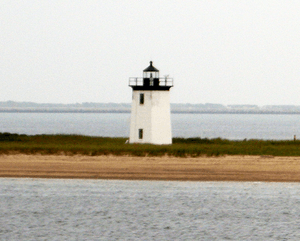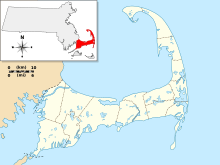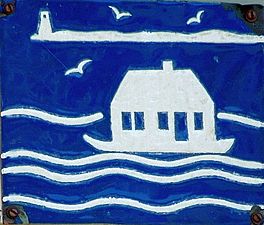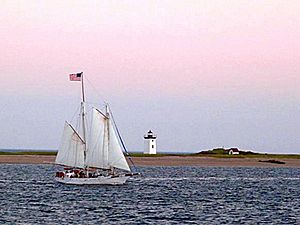Long Point Light facts for kids
 |
|
| Long Point Light in 2010 | |
|
|
|
| Location | Long Point, Provincetown, Massachusetts |
|---|---|
| Coordinates | 42°1′59.23″N 70°10′7.15″W / 42.0331194°N 70.1686528°W |
| Year first constructed | 1827 |
| Year first lit | 1875 (re-built light) |
| Automated | 1952 |
| Foundation | Natural, emplaced |
| Construction | Brick |
| Tower shape | Square tower |
| Markings / pattern | White with black lantern |
| Height | 38 feet (12 m) |
| Focal height | 35.5 feet (10.8 m) above mean sea level |
| Original lens | Oil Lamp (1826); Sixth-order fresnel (1856); Fifth-order fresnel (1875) |
| Current lens | Solar-powered 300 mm lantern (1982) |
| Range | 8 nautical miles (15 km; 9.2 mi) |
| Characteristic | Oc G 4s (Green, occulting every 4 seconds) |
| Fog signal | HORN: one 2-sec blast every 15 secs Previous (1875): 1,200 lb (540 kg) fog bell |
| Admiralty number | J0382 |
| ARLHS number | USA-450 |
| USCG number | 1-13275 |
Long Point Light Station is an old lighthouse located at the very tip of Long Point in Provincetown, Massachusetts. It helps boats find their way into Provincetown Harbor. The lighthouse is a white square tower. Its light shines green and flashes off for a moment every 4 seconds. The light is 35.5 feet (about 10.8 meters) above the water and can be seen from 8 nautical miles away. When it's foggy, you can hear its fog horn. It makes a two-second blast every 15 seconds, almost like it's talking to its nearby neighbor, the Wood End Light.
Contents
History of Long Point Light
The story of Long Point Light begins in 1826. The United States Government spent $2,500 to buy 4 acres of land at Long Point. They wanted to build a lighthouse there to guide ships into Provincetown Harbor, which was a busy fishing port.
The First Lighthouse (1827)
The first Long Point Light was finished in 1827. It wasn't a tall tower like most lighthouses today. Instead, it was an octagonal (eight-sided) lantern placed on the roof of a wooden house where the lighthouse keeper lived. This style was common for early lighthouses on Cape Cod and became known as the "Cape Cod style."
In 1856, a special lens called a "sixth-order Fresnel lens" was added to the lantern. This lens made the light much brighter and easier to see.
The New Lighthouse (1875)
By 1873, the old lighthouse was in bad shape. Inspectors worried that a strong storm could wash it away. So, the Lighthouse Board decided to build a new one.
The lighthouse you see today was finished in 1875. It's a 38-foot (about 11.6-meter) tall, square brick tower. A new keeper's house was also built next to it. This new lighthouse got an even larger "fifth-order Fresnel lens." A big 1,200-pound (about 544-kilogram) fog bell was also installed to help guide ships in foggy weather. In 1904, a small building was added to store the oil used for the light.
Modern Changes
In 1927, the light's brightness was reduced. Then, in 1952, the Long Point Light became automated. This meant a keeper no longer needed to live there to operate it. A modern light replaced the old Fresnel lens.
In 1982, Long Point Light was one of the first lighthouses in Massachusetts to use solar panels. These panels power the light and the fog signal. Around the same time, the old keeper's house and fog signal building were torn down.
The Long Point Light Station was added to the National Historic Register in 1987. Today, only the lighthouse and its 1904 oil house remain on Long Point. This area is now part of the Cape Cod National Seashore.
The Village of Long Point
From 1827 until the late 1850s, the Long Point peninsula was home to a busy village. By 1830, the lighthouse even had the first school in the village, with just three children.
The village grew to include homes for 38 fishing families, a school with up to 60 children, a post office, a bakery, and boat landings. There were also several "saltworks" that used windmills to pump seawater to make salt.
For different reasons, the village eventually closed down. Most families took their houses with them when they left. They put their homes on rafts and floated them across the harbor to Provincetown's West End. Some of these historic "floater" homes are still standing today. You can spot them by looking for special blue and white plaques.
The Long Point Battery
During the American Civil War, around 1863, the Union Army built forts called the Long Point Battery. These forts had two earthwork areas with a total of nine 32-pound guns. There was also a barracks for 98 soldiers, an officer's quarters, and stables.
The base was used until 1872, but it never saw any fighting. Because of this, local people started calling the forts "Fort Useless" and "Fort Ridiculous."
Long Point Light Today
Today, the United States Coast Guard owns and controls Provincetown's three lighthouses: Long Point Light, Wood End Light, and Race Point Light. The Long Point Light is leased to and cared for by the Cape Cod Chapter of the American Lighthouse Foundation.
The lighthouse grounds are open to the public, but you cannot go inside the lighthouse tower.
In 2009, people who wanted to preserve the lighthouse suggested rebuilding the keeper's house. They thought it could become a bed and breakfast, similar to what is done at Race Point. The Coast Guard's lease is set to end in 2015. Local officials think the property might then be given to the National Park Service, which manages the National Seashore.
You can reach the quiet beach by the lighthouse in a few ways. You can rent a small boat or take the Long Point Beach Ferry. The ferry is a 20-minute ride from MacMillian Pier or the Boatyard dock. You can also hike there. The hike is about three miles each way, along the Provincetown Causeway and then along the beach.
Images for kids
-
View from the East (2009). The mound is what remains of the Long Point Battery.
-
Houses bearing this plaque were in the Long Point settlement, and were floated across the harbor
Attribution ![]() This article incorporates public domain material from websites or documents of the National Park Service (retrieved on 2012-03-03).
This article incorporates public domain material from websites or documents of the National Park Service (retrieved on 2012-03-03).









